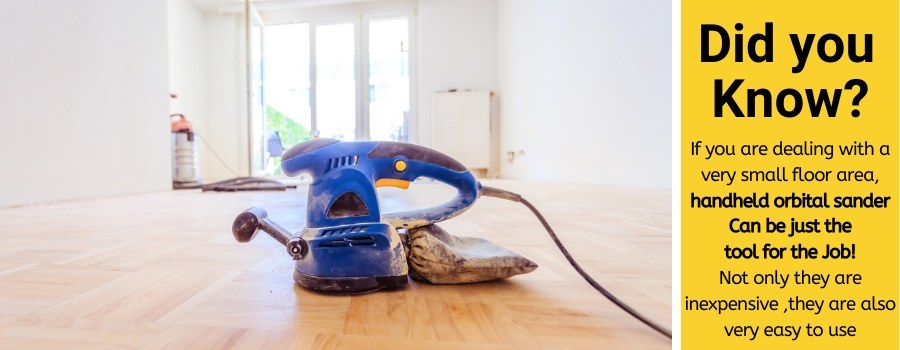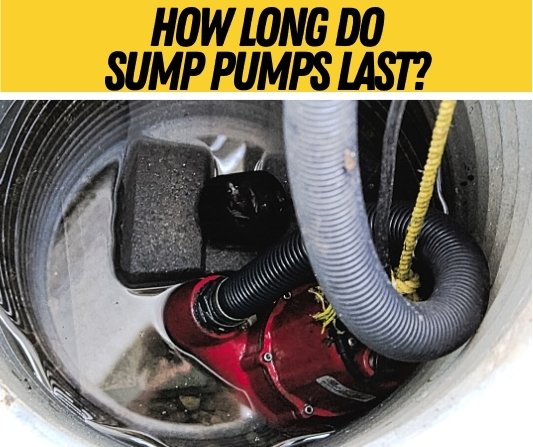 In this article we will be discussing if you can use an orbital sander on Hardwood floors, we will look at both hand held orbital sanders and pro quality stand up orbital floor sanders.
In this article we will be discussing if you can use an orbital sander on Hardwood floors, we will look at both hand held orbital sanders and pro quality stand up orbital floor sanders.
We will see if you should use one, what your other options might be, like using a drum sander or a belt sander. Which one works best and why.
And How to use an orbital sander correctly to get as good a result as possible on your flooring project.
Can You Use an Orbital Sander On a Hardwood Floor?
Yes you can use orbital sander on hardwood floors. However in the case of removing paint, or glue, or sanding a damaged floor with raised an uneven boards an Orbital Sander particularly a handheld model will be a substantially harder and more time consuming job.
An Orbital floor Sander is made for mostly light sanding while a belt or drum sander sands much more aggressively.
Which sander you use is highly dependent on how damaged your floor is and what is your skill level, Orbital sanders work very well for sanding a level unfinished floor and can be used easily and effectively by a novice, while belt and drum sander require some practice and getting used too.
How to Sand New Hardwood Floors With an Orbital Sander
First off make sure you have a dust collector attached to your sander and that you are wearing a dust mask before you start sanding, good ventilation in the room should also be considered.
Secondly the Condition of your floor needs to be considered, an uneven or damaged floor may need to be gone over with a belt or drum sander first to take out the really rough stuff out.
Even if your floors are in relatively good condition its going to take 2 to 3 times longer with an Orbital floor sander and maybe as much as 10 times longer with a handheld model than it will with a drum or belt sander.
Good news is an Orbital sander is easier to use and can be used on floors where the grain goes in multiple directions, like in the case of a herringbone type laid floor. Start sanding with a 60 or 80 grit paper, you may want to use a pad under your paper so it will run more evenly on your floor, go over the entire floor slowly and methodically keeping your sander level and moving constantly, pausing with your sander running can dip or damage your floor quickly. Remember to change your sandpaper on a regular basis it will load up much quicker than you may think, also keep your dust collection bag emptied, a full dust bag doesn’t suck up dust.
Once you’ve finished with one grit vacuum the floor and go over it with a tack rag, then move up to the next finer grit if you started with a 60 grit move to 80 if you started with 80 move to 100 grit. Do not skip grits it will effect your ability to remove scratches from the previous grit and you will end up with a lesser quality floor finish.
You may feel 100 grit is as fine as you need to go or you may want to go up to a 120 grit the smoother the sand the better looking the finish will be. It is imperative that all the dust is removed from the floor and surrounding area before starting your finish, dust or trash can ruin your finish to the point that you need to start over ,use patience above all else.

Refinishing Hardwood Floors with an Orbital Sander
The process for refinishing is the same as above with a few exceptions, some finishes such as paint and oil finishes may be very difficult to take off with an Orbital Sander, also old finishes may be hazardous and you should use a respirator as opposed to just a simple dust mask. Also remove your dust often to a safe outdoor location as the old varnishes may generate heat and be a potential fire hazard.
Make sure all the old finish is removed before trying to put down new finish or the new finish will not take well or be splotchy where it contacts the old finish.
Read More: Sanding after Staining & Sanding Stained wood
How Long Does it Take to Sand a Floor With an Orbital Sander
Generally speaking it will take 2 to 3 times longer to sand your floor with an Orbital floor sander and possibly as much as 10 times longer with a hand held Orbital than with a drum or belt sander, so how long is that roughly? Its 10 hours for every 100 square feet that’s assuming 3 sanding passes with a stand up floor model orbital sander, it could be 80 to 100 hours with a hand held model.
So you may be asking yourself why would I ever want a hand held orbital sander?
Well when used for a job they were made for they are a marvelous pieces of machinery however sanding floors was never there intended purpose. Doesn’t mean you can’t do it just means there are better less time consuming ways to do it. If you already have a handheld orbital sander and you don’t have large amounts of floor to finish it might be not as bad of an idea after all as hiring a professional floor sander is rather costly.
Also read: How To Sand Without Making Mess
Best Orbital Sander for Hardwood Floors
Well the best orbital sander for hardwood floors would be a standup model made specifically for sanding hardwood floors but these are very expensive pieces of machinery and most DIY floor projects will probably use a rental machine or a handheld model the advantage to buying a hand held model is that they are great sanders for other jobs as well for instance I would not even think about a furniture refinishing job without a good orbital sander.
So lets look at a few, here is a link for a variety of Clarke brand professional Orbital floor sanders, unless you plan to start a floor refinishing service you are probably not going to be interested in these other than as a reference as to what to expect from a good rental machine.
On the other hand you may seriously consider a nice hand held orbital sander, if so Bosch makes several models my favorite one has a 6”disc a good dust collector that can also be hooked up to a vacuum and is built for minimal vibration to reduce hand fatigue check out the link below.
Is Orbital Sander Better Than a Palm Sander for Floors?
In a word Absolutely a palm sander is smaller and much harder to keep flat and stable which will result in a wavy poor quality result in your finished floor.
While I totally understand being budget conscious having a tool suitable to do the job will almost certainly produce better results, and be more economical in the long run.
Even renting a tool for a day or two may well be cheaper than buying a new tool or trying to use a tool that’s inadequate, especially if you are only contemplating a one time project. Also I would suggest to look at the prices of orbital sanders- they are not that expensive.Like with most good quality tools you can purchase one , finish your project and sell it back on marketplaces such as ebay for often nearly the same price= Free Rental!
Orbital Vs Drum Sander for Hardwood floor
A Drum sander will remove far more material and finish from your floor in a lot less time, if you have a severely damaged floor and you have access to and experience with a drum sander then by all means I would recommend a drum sander in conjunction with an orbital sander.
The orbital sander should still be used for the final sanding as it will eliminate scratches far more effectively.
If you don’t have experience with a drum sander and don’t really want to tackle the learning curve then stick with the orbital sander. It will take more time but it is a lot easier to handle and less likely to cause damage to your floor.
What Is the Difference Between a Drum Sander and a Orbital Sander?
A drum sander has a sand paper sleeve that slides onto a roller or a block and can be adjusted to skim the surface of your floor the machine is a heavy stand up machine specifically made for refinishing floors however they are limited in the fact that they must be run with the grain of the floor to avoid severe scratches.
In contrast an Orbital Sander uses a flat pad that moves in a small random circular or orbital pattern, therefore it can be used with or against the grain without visibly scratching the wood, also the machine is not pulled in any particular direction like a drum sander is so it makes it easier to control.
Orbital Sander Vs Belt Sander for Hardwood Floors
Like the drum sander the belt sander, even the hand held models can remove material at a much quicker rate than an Orbital but they still are grain directional and pull in one direction, making them more difficult to handle than an Orbital and will scratch your floor if used against the grain.
And they still need to be followed by a orbital sander on the final sand to remove scratches and blend everything to a smooth finish.
What is the Difference Between an Orbital Sander and a Belt Sander?
A belt sander has more in common with a drum sander than with an orbital sander typically a sanding belt is slid in place between two moving rollers and is pulled over a pad between the two rollers where it spins at high rpm in one direction to remove material very quickly.
Once again like the drum sander the singular direction of the belt can cause severe scratches if it is run against the grain of the wood.
Belt sanders are often hand held machines like most orbital sanders which make them somewhat easier to work with than the bulky standup drum sanders but still harder to deal with than the smooth motion of an Orbital sander.
Example of what an actual Random Orbital Sander For floors looks like
What Type of Sander is Best for Hardwood Floors
For the novice DIY guy an orbital floor sander is the best choice, preferably a standup professional model but if you don’t have access to one a hand held orbital will do the job, just expect to spend a lot more time doing it than with a drum sander.
The biggest draw back of a drum sander is they are bulky and hard to manage and they will scratch if they are used across the grain, and they still require you to go back with a smaller edge sander along the edges of your room, and run a finish pass with an orbital sander anyway.
Ideally if your skilled in using a drum sander these 2 sanders can be used together for a quick an efficient job but if you’re inexperienced with a drum sander stick with the Orbital take your time and pay close attention especially around the edges where you’re most likely to find scratches or swirl marks, and you can expect that provided you take as much care with your finish as with your sanding to have a finished floor you can be truly proud of.






